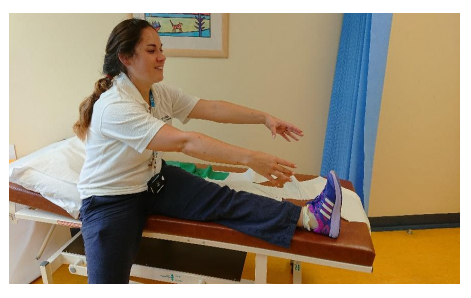This leaflet provides information for children, adolescents and their parents/carers on Osgood-Schlatter disease and offers some exercises to help improve symptoms.
Please note this information is a guide only. Please consult your child’s physiotherapist at Addenbrooke’s Hospital, Physiotherapy Outpatients on 01223 216633 for individual advice and recommendations.
About Osgood-Schlatter disease
Osgood-Schlatter disease is a cause of knee pain in children and adolescents. It affects those who are active and have gone through a rapid growth spurt. During this, the bony prominence beneath their knee (tibial tuberosity) can become painful and swollen, especially if they do sports and activities such as running, squatting, kneeling or jumping.
This happens because the muscles at the front of the thigh (quadriceps) attach to the bony prominence via the kneecap (patella) tendon. During a growth spurt the bones grow first so the thigh muscles have to stretch to catch up and can become tight. When the thigh muscles are tight they pull on the bony prominence and kneecap. This causes pain, particularly during exercise. The bony prominence can also become larger if the person continues to play sports.
What are the symptoms?
- The young person may limp after physical activities because of the pain.
- One or both knees can be painful and swollen below the kneecap.
- The level of pain can vary depending on the type and amount of physical exercise undertaken.
- High impact activities involving running and jumping can result in the knees feeling sore.
- Going up and down stairs may also be painful.
Getting better
Osgood-Schlatter disease generally resolves when young people stop growing. Changing to lower impact activities can also help. It can take several weeks or even months for the pain to settle, but generally, the symptoms will improve with rest and time. In the meantime, the advice below can help to relieve symptoms.
Activity modification
- If the pain is severe, try to avoid high-impact sports that involve running and jumping.
- Try low-impact activities, such as cycling and swimming, to strengthen the muscles and build stamina.
- Rest if the swelling and pain get too much.
- Once the pain has stopped, it is important to gradually build up participation in activities and sport.
- Children and adolescents should take part in activities that are comfortable for them.
- Strategies such as taking short breaks whilst playing team sports allows time for pain to settle.
Ice and elevation
- Ice the affected area for 10 to 15 minutes especially after activity and make sure the skin is protected by wrapping the ice in a towel.
- Elevating the leg after sports if it is painful and swollen can be beneficial.
Lower limb stretches

The following stretches may help to improve thigh muscle flexibility.
Quadriceps stretch (thigh muscle at front)
- Ask the young person to lie on one side, supporting their head with a pillow or on their front as demonstrated in the picture with head turned to the side.
- Place a stretchy band or long towel around their ankle. Using the hand on the same side, they should pull the band gently towards their buttocks until they feel a stretch in their thigh.
- Hold for 20 seconds.
- Repeat on the other leg.
- Repeat four times on each leg, twice a day.
Hamstring stretch (thigh muscle at back)
Stretch one

- Ask the young person to sit on the bed with one leg straight, and the other leg resting off the edge of the bed pointing towards the floor. They should reach forwards with their hands down their straight leg as far as they comfortably can. Make sure they keep that knee straight.
- They should feel a stretch at the back of their thigh.
- Hold for 20 seconds.
- Repeat on the other leg.
- Repeat four times on each leg, twice a day.
Stretch two


- Ask the young person to lie on their back with their head supported by a pillow.
- Place a stretchy band or long towel around the sole of their foot and ask them to hold the band in both hands.
- They should lift their leg up to 90 degrees (Picture A).
- Get them to straighten their leg upwards towards the ceiling as far as they comfortably can (Picture B). It doesn’t matter if there is a small bend in the knee. They should feel a stretch in the back of their thigh.
- Hold for 20 seconds.
- Repeat on the other leg.
- Repeat four times on each leg, twice a day.
The pain can return when there is another growth spurt so make sure the child keeps doing the stretches. Usually, the pain does not continue after they stop growing.
The condition does not result in any long-term damage to the bones or joints even if the child continues their activity, although the bony lump may remain. The amount of activity the child will be able to undertake depends on how well they can tolerate pain.
We are smoke-free
Smoking is not allowed anywhere on the hospital campus. For advice and support in quitting, contact your GP or the free NHS stop smoking helpline on 0800 169 0 169.
Other formats
Help accessing this information in other formats is available. To find out more about the services we provide, please visit our patient information help page (see link below) or telephone 01223 256998. www.cuh.nhs.uk/contact-us/accessible-information/
Contact us
Cambridge University Hospitals
NHS Foundation Trust
Hills Road, Cambridge
CB2 0QQ
Telephone +44 (0)1223 245151
https://www.cuh.nhs.uk/contact-us/contact-enquiries/

